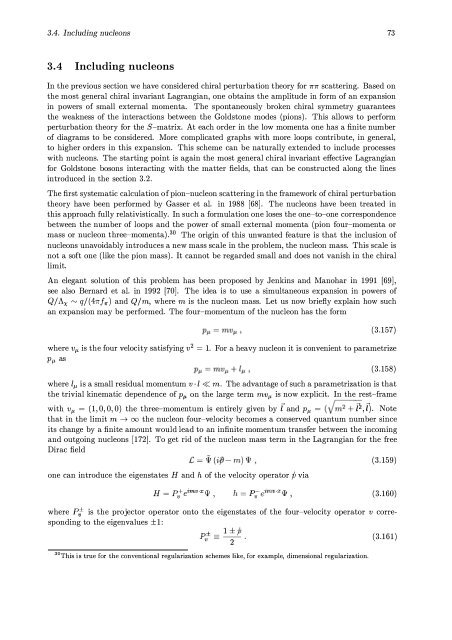The Nucleon-Nucleon Interaction in a Chiral Effective Field Theory
The Nucleon-Nucleon Interaction in a Chiral Effective Field Theory
The Nucleon-Nucleon Interaction in a Chiral Effective Field Theory
Create successful ePaper yourself
Turn your PDF publications into a flip-book with our unique Google optimized e-Paper software.
3.4. Includ<strong>in</strong>g nucleons 73<br />
3.4 Includ<strong>in</strong>g nucleons<br />
In the previous section we have considered chiral perturbation theory for 1r7r scatter<strong>in</strong>g. Based on<br />
the most general chiral <strong>in</strong>variant Lagrangian, one obta<strong>in</strong>s the amplitude <strong>in</strong> form of an expansion<br />
<strong>in</strong> powers of small external momenta. <strong>The</strong> spontaneously broken chiral symmetry guarantees<br />
the weakness of the <strong>in</strong>teractions between the Goldstone modes (pions). This allows to perform<br />
perturbation theory for the S-matrix. At each order <strong>in</strong> the low momenta one has a f<strong>in</strong>ite number<br />
of diagrams to be considered. More complicated graphs with more loops contribute, <strong>in</strong> general,<br />
to higher orders <strong>in</strong> this expansion. This scheme can be naturally extended to <strong>in</strong>clude processes<br />
with nucleons. <strong>The</strong> start<strong>in</strong>g po<strong>in</strong>t is aga<strong>in</strong> the most general chiral <strong>in</strong>variant effective Lagrangian<br />
for Goldstone bosons <strong>in</strong>teract<strong>in</strong>g with the matter fields, that can be constructed along the l<strong>in</strong>es<br />
<strong>in</strong>troduced <strong>in</strong> the section 3.2.<br />
<strong>The</strong> first systematic calculation of pion-nucleon scatter<strong>in</strong>g <strong>in</strong> the framework of chiral perturbation<br />
theory have been performed by Gasser et al. <strong>in</strong> 1988 [68]. <strong>The</strong> nucleons have been treated <strong>in</strong><br />
this approach fully relativistically. In such a formulation one loses the one-to-one correspondence<br />
between the number of loops and the power of small extern al momenta (pion four-momenta or<br />
mass or nucleon three-momenta).30 <strong>The</strong> orig<strong>in</strong> of this unwanted feature is that the <strong>in</strong>clusion of<br />
nucleons unavoidably <strong>in</strong>troduces a new mass scale <strong>in</strong> the problem, the nucleon mass. This scale is<br />
not a soft one (like the pion mass). It cannot be regarded small and does not vanish <strong>in</strong> the chiral<br />
limit.<br />
An elegant solution of this problem has been proposed by Jenk<strong>in</strong>s and Manohar <strong>in</strong> 1991 [69],<br />
see also Bernard et al. <strong>in</strong> 1992 [70]. <strong>The</strong> idea is to use a simultaneous expansion <strong>in</strong> powers of<br />
Q / Ax rv q / ( 41r f 1r) and Q / m, w he re m is the nucleon mass. Let us now briefly expla<strong>in</strong> how such<br />
an expansion may be performed. <strong>The</strong> four-momentum of the nucleon has the form<br />
(3.157)<br />
where vJl is the four velo city satisfy<strong>in</strong>g v 2 = 1. For a heavy nucleon it is convenient to parametrize<br />
PJl as<br />
(3.158)<br />
where lJl is a small residual momentum v·l «m. <strong>The</strong> advantage of such a parametrization is that<br />
the trivial k<strong>in</strong>ematic dependence of PJl on the large term mVJl is now explicit. In the rest-frame<br />
with vJl = (1,0,0,0) the three-momentum is entirely given by f and PJl = cj m2 + [2, T). Note<br />
that <strong>in</strong> the limit m ---+ 00 the nucleon four-velocity becomes a conserved quantum number s<strong>in</strong>ce<br />
its change by a f<strong>in</strong>ite amount would lead to an <strong>in</strong>f<strong>in</strong>ite moment um transfer between the <strong>in</strong>com<strong>in</strong>g<br />
and outgo<strong>in</strong>g nucleons [172]. To get rid of the nucleon mass term <strong>in</strong> the Lagrangian for the free<br />
Dirac field<br />
(3.159)<br />
one can <strong>in</strong>troduce the eigenstates H and h of the velo city operator p via<br />
H =<br />
p+ eimv.x'l!<br />
v ,<br />
(3.160)<br />
where E� is the projector operator onto the eigenstates of the four-velocity operator v correspond<strong>in</strong>g<br />
to the eigenvalues ±1:<br />
30 This is true for the conventional regularization schemes like, for example, dimensional regularization.<br />
(3.161)












